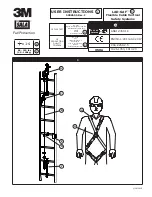
9
•
Periodic Formal Inspection:
A formal inspection of the Lad-Saf
™
X2 Detachable Cable Sleeve, Lad-Saf
™
System
installation, and the structure must be performed at least annually, or in accordance with the specified inspection
criteria for the structure the system is secured to, by a competent person other than the user. See Sections 5.3 and
5.4 for inspection specifics. Record the results at the end of this manual.
•
After a Fall:
If a fall occurs with the Lad-Saf
™
System a formal inspection of the entire system must be performed
by a competent person other than the user.
A separate fall protection system must be used while inspecting
the Lad-Saf system.
See sections 5.3, 5.4 and 5.5. Record the inspection results in the
Inspection and Maintenance
Logs
at the end of this manual.
5.2
If inspection reveals an unsafe or defective condition
remove the Lad-Saf
™
X2 Detachable Cable Sleeve or the
Lad-Saf
™
System from service. Contact an authorized service center for repair or destroy the sleeve. DO NOT ATTEMPT
UNAUTHORIZED REPAIR. Record the results of this inspection in the
Inspection and Maintenance Log
in this manual.
5.3
INSPECTION GUIDELINES - LAD-SAF™ DETACHABLE CABLE SLEEVE:
See Figure 2 for identification of the components
described in the following guidelines:
•
Inspect the handle/energy absorber/fall indicator (item D) for bends, cracks, and deformities. All fasteners must be
securely attached. Operation of handle and cam must be free and smooth. Springs must be secure and of sufficient
strength to pull handle down.
The handle/energy absorber/fall indicator will be deformed if it has been used for fall arrest. Figure 18 shows an
example of a handle/energy absorber/fall indicator that has not been used for fall arrest (A) and a handle/energy
absorber that has been used for fall arrest and is deformed (B).
If the handle/energy absorber is deformed
greater than A = 1/2 inch (12.7mm) DO NOT USE. The sleeve must be removed from service.
•
Inspect the locking lever (item G) for smooth operation, ensuring it springs back into its locked position when
released.
•
Inspect the cam (item L) for wear. Confirm that there is no damage to the cam.
•
Inspect cam (item L) by holding the sleeve vertically with the handle/energy absorber (item D) in the upright position
and shaking the sleeve up and down to simulate a fall. The cam should rotate freely.
•
Inspect cam (item L) by positioning the sleeve horizontally with the handle/energy absorber (item D) in the upright
position and placing the sleeve on the back side on a flat surface with the Lad-Saf X2 label facing up. The cam should
rotate fully upwards to the top of the sleeve.
•
Inspect the operation of the rotating side plate (item C) by pulling it back to try to open the cable slot. It must not
rotate. If it does rotate without having to rotate the locking lever (Figure 2, item G), remove the sleeve from service.
5.4
INSPECTION GUIDELINES - LAD-SAF
™
SAFETY SYSTEM:
Refer to the Installation Instructions supplied with your Lad-Saf
Flexible Cable Vertical Ladder Safety System (
3M Fall Protection manual #5908282 or #5903435) when performing the
inspection procedures described in this section.
A separate fall protection system must be used during the System Inspection.
;
Top Brackets:
•
Inspect for proper installation per Lad-Saf™ Flexible Cable Vertical Safety Systems Installation Instructions, 3M Fall
Protection manual #5908282 or #5903435.
•
Check for visible damage or corrosion. Look for cracks, bends or wear that could affect the strength and operation
of the system. Inspect welds. Look for cracked or broken welds that could affect strength of bracket. Replace parts if
defects are found.
•
Check for loose or missing fasteners that secure top bracket to structure (bolts, clamp plates, U bolts). If fasteners
are loose, re-tighten as necessary to the torque levels listed in the Installation Instructions supplied with your Lad-Saf
Flexible Cable Safety System.
•
Inspect top plate for deformation. See Figure 19. Gap shall be 0.20 inch (5 mm) minimum at location A.
•
Ensure large pin of lug assembly (B) is resting inside of top plate.
•
Ensure small pin of lug assembly is in place.
•
Ensure spring gate (C) is in place.
•
Inspect the single point anchor (D) for cracks or signs of damage. Inspect the torque of the fastener. Ensure washer
has visible markings.
;
Bottom Bracket:
•
Inspect for proper installation per Lad-Saf™ Flexible Cable Vertical Safety Systems Installation Instructions, 3M Fall
Protection manual #5908282 or #5903435.
•
Check for damage or corrosion. Look for cracks, bends or wear that could affect the strength and operation of the
system. Replace parts if defects are found.
•
Check for loose or missing fasteners that secure bottom bracket to the structure. If fasteners are loose, re-tighten as
necessary to the torque levels listed in the Installation Instructions supplied with your Lad-Saf Flexible Cable Ladder
Safety System.
•
Inspect the tension rod assembly. Make certain saddle clips securely retain the cable. Check torque on saddle clamps;
torque to 35 ft. lbs. (47 N-m). Replace or retighten if defects are found.
;
Cable Guides:
•
Check cable guides for damage. Look for wear or damage to black urethane. Cable guides should restrain the cable
and prevent cable contact with the ladder/structure. Cable guides should be positioned at approximately 20-40 ft
(6-12m) along the carrier cable, or closer if required. Replace parts if defects are found.
•
Check cable guide fasteners. The fasteners should the secure cable guide in position. Tighten as necessary.
Summary of Contents for DBI SALA LAD-SAF
Page 3: ...3 8 9 C G L D 10 11 G C A D E 2797 1 2 3 4 5 6 7 8 9 11 9 9 9 10 ...
Page 101: ...100 ...
Page 209: ...208 ...
Page 218: ...217 ...










































